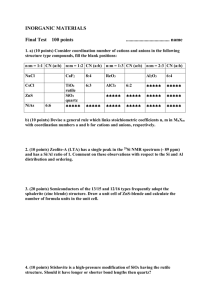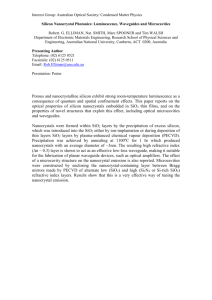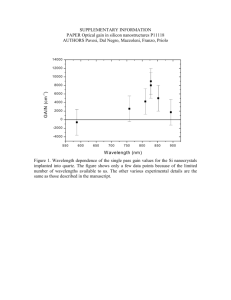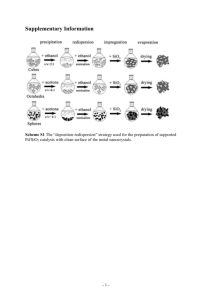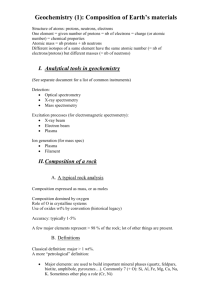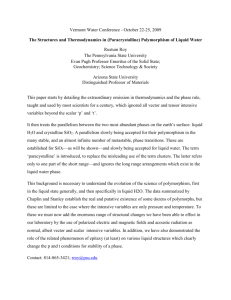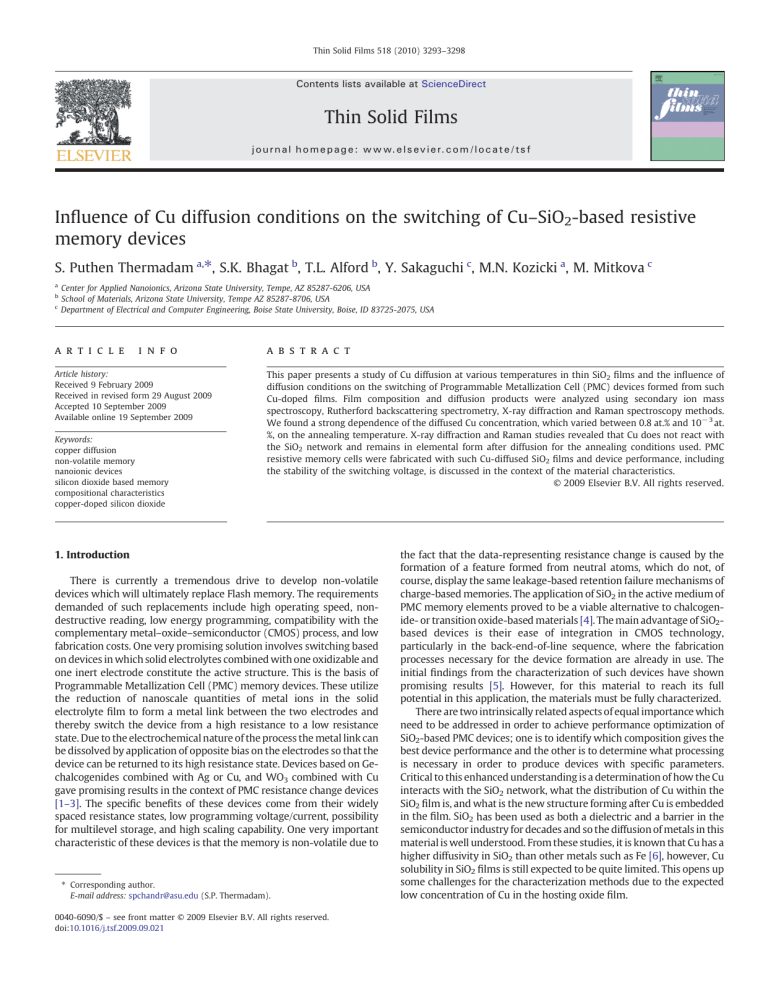
Thin Solid Films 518 (2010) 3293–3298
Contents lists available at ScienceDirect
Thin Solid Films
j o u r n a l h o m e p a g e : w w w. e l s ev i e r. c o m / l o c a t e / t s f
Influence of Cu diffusion conditions on the switching of Cu–SiO2-based resistive
memory devices
S. Puthen Thermadam a,⁎, S.K. Bhagat b, T.L. Alford b, Y. Sakaguchi c, M.N. Kozicki a, M. Mitkova c
a
b
c
Center for Applied Nanoionics, Arizona State University, Tempe, AZ 85287-6206, USA
School of Materials, Arizona State University, Tempe AZ 85287-8706, USA
Department of Electrical and Computer Engineering, Boise State University, Boise, ID 83725-2075, USA
a r t i c l e
i n f o
Article history:
Received 9 February 2009
Received in revised form 29 August 2009
Accepted 10 September 2009
Available online 19 September 2009
Keywords:
copper diffusion
non-volatile memory
nanoionic devices
silicon dioxide based memory
compositional characteristics
copper-doped silicon dioxide
a b s t r a c t
This paper presents a study of Cu diffusion at various temperatures in thin SiO2 films and the influence of
diffusion conditions on the switching of Programmable Metallization Cell (PMC) devices formed from such
Cu-doped films. Film composition and diffusion products were analyzed using secondary ion mass
spectroscopy, Rutherford backscattering spectrometry, X-ray diffraction and Raman spectroscopy methods.
We found a strong dependence of the diffused Cu concentration, which varied between 0.8 at.% and 10− 3 at.
%, on the annealing temperature. X-ray diffraction and Raman studies revealed that Cu does not react with
the SiO2 network and remains in elemental form after diffusion for the annealing conditions used. PMC
resistive memory cells were fabricated with such Cu-diffused SiO2 films and device performance, including
the stability of the switching voltage, is discussed in the context of the material characteristics.
© 2009 Elsevier B.V. All rights reserved.
1. Introduction
There is currently a tremendous drive to develop non-volatile
devices which will ultimately replace Flash memory. The requirements
demanded of such replacements include high operating speed, nondestructive reading, low energy programming, compatibility with the
complementary metal–oxide–semiconductor (CMOS) process, and low
fabrication costs. One very promising solution involves switching based
on devices in which solid electrolytes combined with one oxidizable and
one inert electrode constitute the active structure. This is the basis of
Programmable Metallization Cell (PMC) memory devices. These utilize
the reduction of nanoscale quantities of metal ions in the solid
electrolyte film to form a metal link between the two electrodes and
thereby switch the device from a high resistance to a low resistance
state. Due to the electrochemical nature of the process the metal link can
be dissolved by application of opposite bias on the electrodes so that the
device can be returned to its high resistance state. Devices based on Gechalcogenides combined with Ag or Cu, and WO3 combined with Cu
gave promising results in the context of PMC resistance change devices
[1–3]. The specific benefits of these devices come from their widely
spaced resistance states, low programming voltage/current, possibility
for multilevel storage, and high scaling capability. One very important
characteristic of these devices is that the memory is non-volatile due to
⁎ Corresponding author.
E-mail address: spchandr@asu.edu (S.P. Thermadam).
0040-6090/$ – see front matter © 2009 Elsevier B.V. All rights reserved.
doi:10.1016/j.tsf.2009.09.021
the fact that the data-representing resistance change is caused by the
formation of a feature formed from neutral atoms, which do not, of
course, display the same leakage-based retention failure mechanisms of
charge-based memories. The application of SiO2 in the active medium of
PMC memory elements proved to be a viable alternative to chalcogenide- or transition oxide-based materials [4]. The main advantage of SiO2based devices is their ease of integration in CMOS technology,
particularly in the back-end-of-line sequence, where the fabrication
processes necessary for the device formation are already in use. The
initial findings from the characterization of such devices have shown
promising results [5]. However, for this material to reach its full
potential in this application, the materials must be fully characterized.
There are two intrinsically related aspects of equal importance which
need to be addressed in order to achieve performance optimization of
SiO2-based PMC devices; one is to identify which composition gives the
best device performance and the other is to determine what processing
is necessary in order to produce devices with specific parameters.
Critical to this enhanced understanding is a determination of how the Cu
interacts with the SiO2 network, what the distribution of Cu within the
SiO2 film is, and what is the new structure forming after Cu is embedded
in the film. SiO2 has been used as both a dielectric and a barrier in the
semiconductor industry for decades and so the diffusion of metals in this
material is well understood. From these studies, it is known that Cu has a
higher diffusivity in SiO2 than other metals such as Fe [6], however, Cu
solubility in SiO2 films is still expected to be quite limited. This opens up
some challenges for the characterization methods due to the expected
low concentration of Cu in the hosting oxide film.
3294
S.P. Thermadam et al. / Thin Solid Films 518 (2010) 3293–3298
In our previous work we noted that the introduction of Cu by
photodiffusion (as used in the formation of Ge-chalcogenide solid
electrolytes) is not favored [4] due to the specific bond organization
and strength of the chemical bonding in SiO2. Other options are
thermal diffusion and ion implantation which have been successfully
applied to the introduction of Cu in SiO2 films [6,7]. We have used
thermal diffusion since this method of metal introduction is more
acceptable than Cu ion implantation in mainstream semiconductor
processing due to the lack of readily available implant sources. In this
article we discuss the results of Cu diffusion into SiO2 films at different
annealing temperatures and times. Data is presented regarding the
new structure forming after Cu diffusion in the hosting SiO2 film and
its depth distribution using a variety of characterization techniques.
These material characterization results are related to the performance
of PMC devices prepared under different conditions.
This work is aimed at giving a general perspective of the material
options that could be used in device fabrication and to be a model
for the explanation of device performance as a function of processing
conditions.
2.2. Device preparation
A schematic of a typical PMC device structure is shown in Fig. 2. A
100 nm thick tungsten layer was deposited using a chemical vapor
deposition (CVD) process on thermally grown SiO2 on a Si substrate.
100 nm of silicon nitride was deposited on top of this tungsten layer
using CVD and vias which define the active device regions were
patterned using optical lithography and etched using a reactive-ion
etching process to expose the bottom tungsten film. The via diameters
varied from 5 µm to 0.18 µm. Probe windows to contact the tungsten
bottom electrode were opened up using another lithography and etch
process. 15 nm of SiO2 and 40 nm of Cu were deposited on this
patterned substrate under similar deposition conditions as the
samples used for material characterization. The top electrode (Cu)
for electrical probing was then patterned by a lift-off process. A
protective layer of SiO2 was deposited on top of the Cu electrode to
prevent its oxidation during the thermal treatment. This layer was
etched off using 20:1 BOE after the annealing process. The annealing
conditions of the devices were at 560 °C, 660 °C and 720 °C for 15 min
in N2 (flowing) ambient.
2. Experimental details
2.3. Material characterization
2.1. Material stack preparation
All material characterization experiments were performed on blanket
films of Cu-doped SiO2 on a TiN/Si substrate. The TiN layer formed a
diffusion barrier for Cu and prevented Cu diffusion into the Si substrate. In
this manner we avoided the opportunity for contact between the diffused
Cu and the pure Si substrate, which could lead to additional reactions that
would complicate the interpretation of the experimental results. The SiO2
and Cu films were deposited using a Torrvac VC-320 electron beam
evaporator at an average evaporation pressure of 4× 10− 4 Pa and 0.2 nm/
s deposition rate. The stack sequence for the material characterization
samples from top to bottom was as follows: 750 nm SiO2; 350 nm Cu;
550 nm SiO2; 80 nm TiN. The top SiO2 layer was used to prevent the
oxidation of the Cu film during the thermal processing of the samples.
The high temperature thermal doping of SiO2 with Cu was carried out in a
Lindberg Tube Furnace in an N2 (flowing) ambient. The stacks were split
into several groups, each one annealed at 560 °C, 660 °C, or 720 °C for
15 min, 1 h or 2 h respectively. After high temperature processing, the
top SiO2 layer was etched off using a buffered oxide etch (BOE). It is a 20:1
mixture of hydrofluoric acid with ammonium fluoride as buffering agent.
To exclude the influence of the top Cu film, following the thermal
processing it was dissolved with a standard Cu etchant 49-1 from
Transene Company, Inc., a citric acid based etchant with an estimated
etch rate of 22 Å/s at 30 °C. Fig. 1 represents the stack used for this study
and the layer structure after dissolution of Cu. This structure was then
analyzed to provide data regarding the Cu diffusion in the SiO2 film.
Fig. 1. Schematic of the blanket stack used for material characterization.
X-ray diffraction analysis (XRD) was used to identify phases formed
in the as-deposited and annealed samples. One degree glancing scan
XRD was performed using a Phillips X'pert MPD diffractometer. Cu Kα
radiation was used as the source and samples were investigated over an
angle range of 5–100° with 0.01° step size and 1 s time per step. The
voltage and current settings were 45 kV and 40 mA respectively. In the
glancing scan XRD analysis, the angle of source from the sample surface
is fixed at a lower value (1° in our case) while the detector moves in the
usual manner. In a θ–2θ geometry scan, the angle of incidence is always
equal to the angle of exit. Hence, at higher angles to detect higher plane
reflections, the penetration depth of X-rays may be greater than the
thickness of a thin film, resulting in unwanted substrate peaks and noise.
Glancing angle X-ray diffraction reduces this to a significant extent,
however, it provides a larger interaction volume within the studied thin
film as compared to the θ–2θ geometry scan.
Rutherford backscattering spectrometry (RBS) was performed
using a 2.0 MeV He++ ion beam at a tilt of 8° in a General Ionex
Tandetron accelerator. A tilt of 50° was used as well to improve depth
resolution and verify the Cu distribution in the film. A computer
program RUMP was used to simulate RBS spectra [8].
Secondary ion mass spectrometry (SIMS) was done in a Cameca
IMS 3f magnetic-sector SIMS instrument. O− ions at 17 keV and 50 nA
ion current were used as the primary ions since their application
minimizes the charging problems in the SiO2 films. Positive ion mass
spectra and depth profile were obtained. The depth scale of the depth
profile was determined from Tencor stylus profilometer linescan
measurements across the sputter crater.
Raman spectra were recorded using a Raman spectroscopic system, Horiba Jobin Yvon T64000, in backscattering geometry. The
441.6 nm laser line of the helium–cadmium continuous wave laser
Fig. 2. Schematic of the PMC device structure used for electrical testing of the Cu–SiO2
films.
S.P. Thermadam et al. / Thin Solid Films 518 (2010) 3293–3298
3295
(Kimmon Koha Co., Ltd. IK5752 I-G) at a power of 83 mW was used for
the excitation at an acquisition time of 1 min. The signal was analyzed
with a thermoelectrically cooled CCD camera.
2.4. Device characterization
The switching characteristics of the devices annealed at different
temperatures were studied using slow voltage sweeps. These were
applied by connecting the device electrodes via tungsten probes held
in a micromanipulator in a probe station to a semiconductor
parameter analyzer (Agilent 4155C). Voltage double sweeps were
used, starting at − 0.75 V (copper electrode negative and tungsten
electrode positive), sweeping to 1.5 V (copper electrode positive and
tungsten electrode negative), and sweeping back again to − 0.75 V.
For a typical PMC device with oxidizable and inert electrodes, this
double sweep should have put the devices in an erased (high
resistance) state to start with, written them with the positive bias,
and then erased them with the final negative bias, however, as we will
see later, some devices in this study showed unipolar (the same
polarity for both write and erase) characteristics. The compliance
current setting in the 4155C was used to limit the current passing
through the device once the device was written.
3. Results
The results regarding the amount of copper diffused into the SiO2
films measured by SIMS are shown in Fig. 3. Concentration is calculated with respect to silicon by assuming that the ion yield of Cu+
and heavily oxidized silicon is approximately the same (within a
factor of 5). The ratio of Cu+/Si+ is then taken as the concentration
of Cu+. The interface profile is not characterized by a sharp difference between the two films which is an indication that the interdiffusion starts even during the time of the copper film deposition.
There is approximately three orders of magnitude difference in the
amount of diffused Cu for the two temperatures studied; approximately 0.8 at.% for diffusion at 720 °C and around 10− 3 at.% for
+
diffusion at 560 °C. The spectra follows the standard Cu+
63 and Cu65
isotope ratio nicely.
Fig. 4a) and b) shows the RBS spectra taken from a Cu-doped-SiO2/
TiN structure. The amount of Cu diffused in the SiO2 film after
annealing at 560 °C could not be detected in this experiment since it is
below the sensitivity limit of the technique. For the sample annealed
at 720 °C for 15 min the experimental curve shows a faint signal near
channel 300 in addition to the major Si and oxygen peaks. Ti also
produces peaks close to this region. Furthermore, we see two more
peaks close to channel 400. Since the signals from Cu and Ti are very
close, fine calibration is needed for a detailed description of the
Fig. 3. SIMS profiles of Cu in SiO2 films for different diffusion conditions.
Fig. 4. RBS spectra of Cu-doped films. a). After annealing at 560 °C for 2 h. b). After
annealing at 720 °C for 15 min.
composition studied. We suggest that the signal at channel 300 comes
from Ti under the SiO2 film, and the wide signal at channel 320
belongs to Cu at the SiO2/TiN interface. Given that the width of the Cu
peak is greater than the system energy resolution (~7 channels), this
is an indication that Cu exists at the interface with the TiN. The signal
at channel 430 reveals a surface nature and we assign it to the Cu that
is part of the first diffused quantity.
Fig. 5 shows the XRD data collected from our films. Among the
numerous peaks that are characteristic for all the participating elements
and compositions we can observe those of Cu which are the only peaks
Fig. 5. X-ray diffraction data from sample with no thermal doping of Cu and samples in
which thermal doping was done at 560 °C for 2 h and 720 °C for 15 min respectively.
3296
S.P. Thermadam et al. / Thin Solid Films 518 (2010) 3293–3298
Fig. 6. Raman spectroscopy data for a Cu-doped SiO2 film approximately 650 nm thick.
SiO2 was doped with Cu by annealing at a) 560 °C for 15 min, 1 h and 2 h and b) 1 h at
560 °C, 660 °C and 720 °C.
related to this element, i.e., our results show that Cu remains in
elemental form during processing. The intensity of these peaks rises
with increasing annealing temperature.
The Raman results in Fig. 6a) and b) show in a most impressive
manner the dependence on the film's characteristic upon the
annealing conditions. The Raman mode intensity characteristic for
the SiO2 films decreases with increasing annealing time or temperature and no new features occur with the extension of the annealing
conditions. Note specifically the strong decrease of the Raman activity
with temperature caused by annealing at 660 °C. The films are characterized by a relatively sharp band at 440 which arises from symmetrical Si–O–Si stretching modes principally involving motion of the
oxygen atom. The modes at 510 and 640 cm− 1 occur from symmetric
stretching modes of small-ring configurations in the three-dimensional random network [9]. There are two very weak features at 1060
and 1190 cm− 1 which are not shown because of their low relevance
and for a clearer presentation of the modes at lower wavelengths.
Note that Cu is not expected to appear on these spectra since it is
Raman silent [10] but its presence in the films can be inferred from the
reducing Raman activity of the hosting film due to its increased
conductivity because of the Cu inclusion. If Cu oxidation occurred
during the annealing process, features could be expected in the 290–
624 cm− 1 region [11].
Fig. 7a) and b) shows representative I–V characteristics of devices
formed by films annealed at 720 °C and 660 °C, respectively. Note that
both unipolar and bipolar switchings are possible. The progression of
the voltage sweep is shown with the help of numbered arrows,
indicating the direction of the voltage sweep and the sequence of the
events during the sweep. The device conducts a current equal to the
Fig. 7. I–V device characteristics. a) Device annealed at 720 °C showing low switching
threshold for unipolar switching. b) Device annealed at 660 °C showing higher
switching thresholds and bipolar switching.
compliance current, 25 µA in this case, when it is written or switched
ON at the switching threshold voltage. The device conducts negligible
current once it is erased or switched OFF. In Fig. 7 a), which shows
symmetrical unipolar switching (both write and erase in either
polarity), the device follows a sequence of OFF(4)–ON(5)–OFF(9)–ON
(12), (the numbers in parentheses refer to the corresponding
numbered arrow in the figure). In the case of the bipolar switching
shown in Fig. 7 b) it follows the sequence ON(3)–OFF(8). In both
cases, three consecutive voltage sweeps are shown. It should be noted
that the switching threshold is higher (~0.5 V) for the bipolar switching device. The switching threshold shows a close dependence on the
annealing temperature and decreases for samples with films annealed
Fig. 8. Switching thresholds of the first voltage sweep on the device after processing.
S.P. Thermadam et al. / Thin Solid Films 518 (2010) 3293–3298
Fig. 9. Switching threshold variation with subsequent voltage sweeps.
at higher temperature as shown in Fig. 8. We show the threshold
voltage occurring after the first sweep since it gives a better
understanding of the influence of the thermal doping alone, because
switching in the subsequent sweeps could be influenced by a change
in the material caused by the previous voltage sweep. Indeed, multiple sweeps show that switching on average occurs at lower
threshold voltage after the initial sweep, particularly for the lowest
annealing temperature, as shown in Fig. 9.
4. Discussion
We will start our discussion with some remarks about the host
SiO2. Although this material has been widely studied, there is little
data regarding SiO2 films formed by e-beam evaporation, which could
be due to the fact that this method of film formation is not typically
used in conventional Si processing. The films are amorphous as
revealed by the wide Raman and XRD features. In our case, the e-beam
evaporated film was deposited over a polycrystalline TiN film. Hence,
one can expect an increased number of defects compared to a thermal
oxide grown on single crystalline Si. Indeed the appearance of the
‘defect Raman bands’ at 510 and 640 cm− 1 on Fig. 6 a) and b) is direct
evidence of the high disorder of the structure [9]. This disorder will
result in the formation of voids within the oxide film which are
favorable for the diffusion process and almost certainly play a role in
the switching process (discussed later). Note that although the
structure of our evaporated oxide differs from that of thermally grown
oxide, it will be close to that of sputtered oxide, particularly with the
slow deposition rate used. We can infer this from PMC device
characteristics, which are quite similar for evaporated and sputtered
oxides.
Cu has a relatively high diffusivity in SiO2 and isotope tracking
analysis shows that it can penetrate far into an SiO2 film [12,13].
Moreover, this latter study has shown that Cu can move bidirectionally (in and out of the oxide film) which is an indication that it does
not chemically react with the SiO2 matrix. This result is in a good
agreement with the RBS data obtained in our study where we
identified Cu at the SiO2/TiN interface as well as near the Cu/SiO2
surface, which is also a sign of the high mobility of Cu in the SiO2 film.
A similar distribution has also been reported by Sun at al. [14].
When we discuss the thermal diffusion of Cu into the SiO2 film, we
have to consider the temperature-related changes occurring within
the hosting material. It has been found that by increasing the
temperature, electronically excited states are accumulated in the
skeletal Si–O bond system as well as by formation of associates in the
cationic and anionic sublattices [15]. The net result of this is that an
additional energy reservoir appears which is favorable for the
diffusion process at increased temperatures. Moreover, the dynamic
exchanges in the structure of the hosting SiO2 film leads to formation
3297
of films with increased porosity. It is for this reason, and the others
given above, that the Cu diffusion is significantly accelerated at higher
temperature. We see evidence for this increased diffusivity in the
Raman spectra where at increased annealing time and temperature
the intensity of the Raman modes decreases due to the higher
conductivity of the material with higher metal concentration.
Next, we have to consider the fact that we are dealing with a multilayer structure which can result in significant thermal stress and
residual strain-induced effects. For example, it has been noted that the
void formation rate in SiO2 with a Cu metal film deposited on top
increases with an increase in temperature [16]. In general, due to the
difference in the thermal expansion coefficients of the different films
in the stack, significant stresses are expected to occur in the hosting
medium. Indeed, the slight shift of the Raman modes compared to the
relaxed SiO2 [9] is an indication of the strain occurring in the material.
Stress- or point-defect relaxation can occur at any of the studied
temperatures and this is an additional reason for enhancement of the
diffusion process. Pan et.al. [7] noted an optimum annealing condition
around 600 °C to improve indentation induced precipitation. Our
results show a drastic decrease in the intensity of the Raman
breathing modes after annealing at 660 °C which is an indication for
enhanced Cu diffusion at this temperature. The same Cu-related trend
is noted for the threshold voltage for the first sweep which is
considerably lower in the devices annealed at 660 °C compared to
those annealed at 560 °C. Our assumption is that the latter devices
have higher switching thresholds due to the lower concentration of
Cu introduced into the SiO2 matrix, while for those annealed at 660 °C
there is well expressed nanoparticle precipitation and growth [7]
which contribute to the devices switching at lower threshold voltage.
From the XRD results, we conclude that Cu does not react with the
constituents of the SiO2 network and remains in elemental form when
diffused into the dielectric film, leaving most Si atoms in a
configuration with four oxygen bridging atoms. The lack of formation
of CuO or other oxides, silicates or silicides was also demonstrated by
our Raman spectra. Our results are in a good agreement with the data
reported by Dallaporta et al. [16]. Moreover the Cu transport that we
will discuss next is also suggestive that Cu remains free into the SiO2
matrix. These results contradict the data described by Cao et al. [17]
who suggest the formation of Cu3Si in their study of the diffusion
processes in the Cu/SiO2/Si system at temperatures over 450 °C. We
believe that their result is a consequence of the fact that Cu, due to its
relatively high diffusivity, has reached the SiO2/Si interface as discussed earlier and formation of silicides is possibly due to Cu reaction
with pure Si.
Applying our newly-gained knowledge of material characteristics to
the electrical performance of the PMC devices studied, we can better
comprehend their operation. Since the concentration of Cu is quite low
in the as-diffused glass in all cases, there will be insufficient metal to
significantly influence the resistivity of the material and hence the
resistance of the device will be relatively high. When a positive bias is
applied across the Cu-doped films via a Cu electrode, which can be
regarded as a supplier of Cu+, accelerated diffusion of Cu+ will occur
due to the reduction in the activation energy [18,19] and the presence of
the large number of voids and pathways in the host glass, as discussed
above. One can conclude that resistance reduction in the devices is due
to the addition of Cu into the void-filled random network of the hosting
glass, where it joins the existing Cu to form conducting Cu-rich pathways. An opposite bias (Cu electrode negative) takes this added material
out of the glass and back to the Cu electrode by the same process,
returning the device to its high resistance state.
As noted above, annealing at higher temperatures results in much
more Cu being introduced into the SiO2 due to the larger number of
voids formed compared to the lower temperature annealing cases. It is
likely that this same void-rich structure will also allow Cu to enter the
film more easily under positive bias. We suggest this is the reason that
devices formed from material diffused at higher annealing temperature
3298
S.P. Thermadam et al. / Thin Solid Films 518 (2010) 3293–3298
have a lower threshold voltage. This chemically stable but “open”
strucure facilitates the transport of Cu and at the same time does not
create conditions for the chemical stabilization of Cu as oxide within the
glass. We also believe that the fact that Cu does not form chemical bonds
with the SiO2 host is the reason for the fluctuations in the threshold
voltage values from device to device obtained for the same programming conditions (see Fig. 8) and during multiple sweeps (Fig. 9), as the
unbound Cu can readily be thermally (during processing) or electrically
(during programming) redistributed within the film. Note also that
the multiple sweeps result in minimum threshold dispersion at an
annealing temperature of 660 °C (Fig. 8) and we therefore believe this is
close to the optimal conditions for solid electrolyte formation. The
decrease in the average switching threshold voltage with consecutive
sweeps, particularly evident in the case of the samples annealed at
560 °C which have the lowest initial (as-processed) Cu content and
show a 0.1 V average drop after five sweeps, could very well be indicative of a type of “conditioning effect”. Such a large drop in threshold
voltage is not seen in the samples which have been annealed at the
highest temperature and therefore have the highest as-processed Cu
content. We believe that the electrical conditioning which leads to the
drop in threshold voltage is due to the net addition of Cu during cycling
(fewer Cu ions are removed from the SiO2 during the erase than are
introduced during the write), so that the Cu concentration is brought
closer to an equilibrium level with increasing sweep number. The
samples annealed at higher temperature are already closer to this
equilibrium level following processing and therefore do not exhibit such
a strong threshold reduction effect.
The appearance of devices processed at higher temperature which
exhibit both symmetrical unipolar and non-symmetrical bipolar switchings can be understood by considering the RBS results (Fig. 4b). We
believe that this effect is related to the fact that in some instances, Cu
diffuses across the entire thickness of the SiO2 film to the SiO2/W
interface, thus forming a symmetrical Cu–SiO2–Cu structure which leads
to programming or erasing in either direction. Note that in such devices,
the erase mechanism could involve the thermal dissolution of the
conducting Cu filaments due to Joule heating, rather than an
electrochemical oxidation of the metal. In the case of bipolar switching,
Cu remains in the SiO2 volume and the devices only program and erase
under Cu electrode positive and Cu electrode negative biases respectively, as expected for non-symmetric device structures.
5. Conclusions
In this work we present material characterization of Cu-doped
SiO2 films which are used as the active film in PMC resistive switching
devices, and link the material properties to switching characteristics.
It was found that for the range of annealing conditions used (560 °C to
720 °C), the thermal diffusion product for Cu films on evaporated SiO2
layers is an oxide matrix with embedded unreacted Cu atoms. This
result has been confirmed by XRD and Raman measurements. Based
on the characterization data, we propose that Cu diffusion in SiO2
occurs via channels and voids formed in the glassy network, the
presence of which increases with an increase in the annealing tem-
perature and results in high Cu concentration within the film. The
electrical characterization of PMC devices formed from these
materials shows a close relationship between the threshold voltage
of the devices and the annealing conditions for Cu diffusion. The
lowest threshold voltage was obtained for material diffused at the
highest temperature because of the high Cu concentration due to the
higher number of voids present at this temperature. The fact that Cu
does not form chemical bonds with the SiO2 network allows the Cu to
remain mobile within the oxide which leads to variations in the
switching threshold voltage from device to device following processing and fluctuations in this parameter in the same device during
programming sweeps. The smallest variations are observed with films
annealed at 660 °C. The average switching threshold voltage of
samples annealed at the lowest temperature is found to decrease with
the number of write–erase cycles. This is most likely due to the Cu ion
concentration approaching an equilibrium value during cycling in
these initially low Cu concentration samples as the effect is not so
evident in the case of high Cu content materials produced by annealing at higher temperature. Higher temperature annealing can
result in the formation of devices with a Cu/SiO2/Cu structure as Cu
could diffuse through the entire volume of SiO2 and accumulate on the
interface with the bottom electrode, forming a symmetric structure.
These devices tend to show symmetric unipolar switching. Nonsymmetric bipolar switching is exhibited by devices with a Cu/SiO2/W
structure, more typical of moderate to lower temperature annealed
devices.
References
[1] M.N. Kozicki, M. Park, M. Mitkova, IEEE Trans. Nanotechnol. 4 (2005) 331.
[2] M.N. Kozicki, M. Mitkova, M. Park, M. Balakrishnan, C. Gopalan, Superlattices
Microstruct. 34 (2004) 459.
[3] C. Gopalan, M.N. Kozicki, S. Bhagat, C. Powelait, T. Alford, M. Mitkova, J. Non-Cryst.
Solids 353 (2007) 1844.
[4] M. Balakrishnan, S. C. P. Thermadan, M. Mitkova M. N. Kozicki IEEE Proceedings
2006 Non-volatile Memory Technology Symposium, 5–8 November 2006 San
Mateo, California, USA p. 104.
[5] C. Schindler, S.C. Puthen Thermadam, R. Waser, M.N. Kozicki, IEEE Trans. Electron
Devices 54 (2007) 2762.
[6] B. Johannesen, P. Kluth, C.J. Glover, G.J. Foran, M.C. Ridgway, Nucl. Instrum. Phys.
Res. B 242 (2006) 113.
[7] J. Pan, H. Wang, Y. Takeda, N. Umeda, K. Kono, H. Amekura, N. Kishimoto, Nucl.
Instrum. Phys. Res. B 257 (2007) 585.
[8] L.R. Doolittle, Nucl. Instrum. Methods Res. B 9 (1985) 344.
[9] R.J. Hemley, H.K. Mao, P.M. Bell, B.O. Mysen, Phys. Rev. Lett. 57 (1986) 747.
[10] Y.S. Gong, C. Lee, C.K. Yang, J. Appl. Phys. 77 (1995) 5422.
[11] J.F. Xu, W. Ji, Z.X. Shen, W.S. Li, S.H. Tang, X.R. Ye, D.Z. Jia, X.Q. Xin, J. Raman
Spectrosc. 30 (1999) 413.
[12] J.D. McBrayer, R.M. Swanson, T.W. Sigmon, J. Electrochem. Soc. 133 (1986) 1242.
[13] S.-W. Lee, Y.-H. Kim, K.-S. Kim, B.-S. Hong, B.-Y. Lee, J. Korean Phys. Soc. 48 (2006)
1548.
[14] Y.-M. Sun, S.Y. Lee, A. Lemonds, J. Lozano, J.-P. Zhou, J.G. Ekerdt, J.M. White, I.
Imesh, Surf. Interface Anal. 32 (2001) 79.
[15] V.B. Kopylov, K.A. Aleksandrov, E.V. Sergeev, Russ. J. Gen. Chem. 78 (2008) 868.
[16] H. Dallaporta, M. Liehr, J.E. Lewis, Phys. Rev. B 41 (1990) 5075.
[17] Bo Cao, G.-P. Li, X.-M. Chen, S.-J. Cho, H. Kim, Chin. Phys. Lett. 25 (2008) 1400.
[18] I. Fisher, M. Eizenberg, Thin Solid Films 516 (2008) 4111.
[19] Y. Shacham-Diamand, A. Dedhia, D. Hoffstetter, W.G. Oldham, J. Electrochem. Soc.
140 (1993) 2427.


